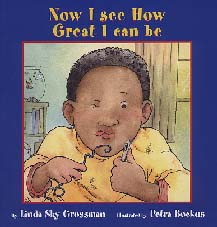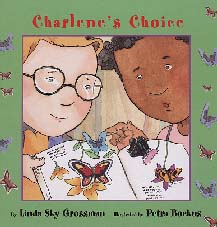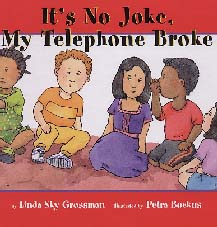| ________________
CM . . .
. Volume VIII Number 11 . . . . February 1, 2002
exerpt:
Accompanying promotional material states that the I'm a Great Little Kid Series was "published in conjunction with the Toronto Child Abuse Centre, who believe that empowering young children makes them less vulnerable." The three titles, therefore, share a similar broad purpose and are presented in a consistent format, with the full page colour illustrations normally on the rectos and the text on the facing page. Each book, which is written in four-line stanzas with pairs of lines rhyming, occurs in a multi-racial school setting. Focusing on the idea of self-concept is Now I See How Great I Can Be which features Niron who is sharing with his Teddy Bear an event that occurred at school that day. When confronted with the task of threading a needle, Niron had decided that it was too difficult to do, and he simply gave up, signaling his defeat by putting his head down between his arms on his desk. His teacher, instead of chastising him, provided supportive, encouraging words, and Niron tried again, this time succeeding. With a changed opinion of himself, Niron decides he can help others and can seek help from teachers when he needs it. Making choices is the concept behind Charlene's Choice which finds her sharing a science project about butterflies with classmate Sam. After going to the library, the two each take out a book, but Sam likes his book so much that, when it comes time to return it, he has other plans.
Now Charlene must choose between letting Sam become a thief or possibly causing him to become angry at her for tattling. She elects to talk to her teacher, Mr. Russell, who tells her that the project taught her more than facts about butterflies. The story's conclusion is somewhat inconclusive for, after the pair's chat, Mr. Russell says that he had found the borrowed book on his table, leaving readers to wonder if Sam had actually already returned the book or had just forgotten it on the teacher's table. It's No Joke, My Telephone Broke is about communication. Sam tells Amon about a game, Broken Telephone, that they played that day at school. In the game, the children sat in a circle, and the teacher whispered a sentence in the ear of the first child, Niron, who then passed the message on to the next child. This pattern of behavior continued until it reached the last child, Vesna. When the teacher asked her to say out loud what she had heard, she said, "Butter tarts slide into the sea," everyone laughed, and Niron piped up, stating, "I said, Butterflies always fly free." Vesna is hurt by her classmates' laughter for she had only repeated what she heard.
The teacher steps in, and while clarifying that the laughter is not directed at Vesna, she makes the point that adults, as well as children, listen without hearing. However, prior to the teacher's talking about communication, she did admonish the children, saying, "Laughing at others I will not permit." While this message is appropriate for the purpose of creating a safe and supportive classroom, it does confuse what the message of the book was supposed to be, something that should not occur in a book about clear communication. All three books conclude with a page "For Grown-ups" which contains a brief paragraph about the books' individual themes of acquiring positive self-esteem, making choices and communicating effectively. Each book then suggests five simple but basic things that parents can do to help their children to achieve the book's focus. For instance, two of the suggestions related to It's No Joke, My Telephone Broke are: Talk with them: Give lots of opportunity for children to participate in conversation. Guide them: Recognize that words are powerful and use positive messages when responding to your children. While the purposes behind these books are laudable, their degree of success is mixed. Children's literature has always suffered from those who, seeking to use it as the sugar-coated vehicle for delivering a "lesson" to the child reader, have forgotten that no message will be received if, in the first instance, the book's story does not engage children. The plots of the three books had the potential to grab their young listeners/readers but fell short of achieving their full possibilities, in part because of the use of poetry as the narrative medium. Writers who are trying to create both good stories and good poetry will likely face the question, "Does the plot shape the poetry, or do the demands of the poetic form alter the plot?" In at least two of the books, the needs of poetry superceded those of the story line. For example, in It's No Joke, My Telephone Broke, the teacher said:
While "proud" does rhyme with "loud," there was nothing in the page between Vesna's feeling "like an empty, crushed can of pop" and this page to suggest to the child reader that Vesna was experiencing any emotion of pride. As well, adults who are not experienced in reading out loud frequently have difficulty with reading poetry, especially rhyming couplets which are often then delivered in a sing-song fashion which creates "noise" that obscures the words' meanings. Finally, the closing "For Grown-ups" page suggests that perhaps the books were actually written not for children but for those parents who need to improve their child-rearing skills and that the whole purpose of the stories was just to get the parents to this last page so that they, not their children, will read and learn. Recommended with Reservations. Dave Jenkinson teaches courses in children's and adolescent literature in the Faculty of Education, the University of Manitoba.
To comment on this
title or this review, send mail to cm@umanitoba.ca.
Copyright © the Manitoba Library Association. Reproduction for personal
use is permitted only if this copyright notice is maintained. Any other
reproduction is prohibited without permission.
Published by
NEXT REVIEW |TABLE OF CONTENTS FOR THIS ISSUE - February 1, 2002.
AUTHORS
| TITLES | MEDIA REVIEWS
| PROFILES
| BACK ISSUES
| SEARCH | CMARCHIVE
| HOME
|


